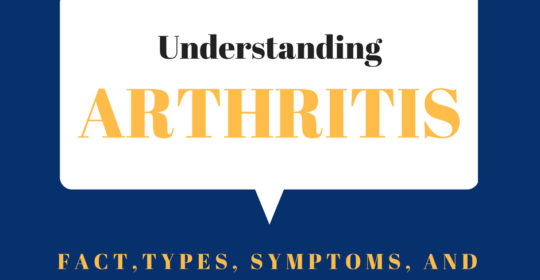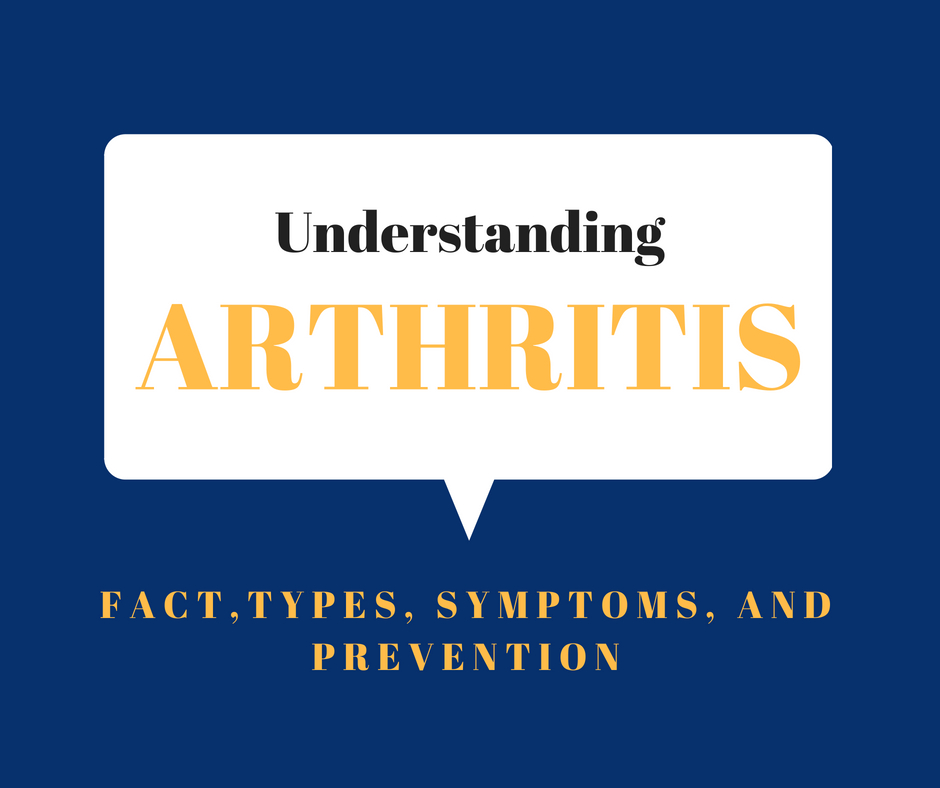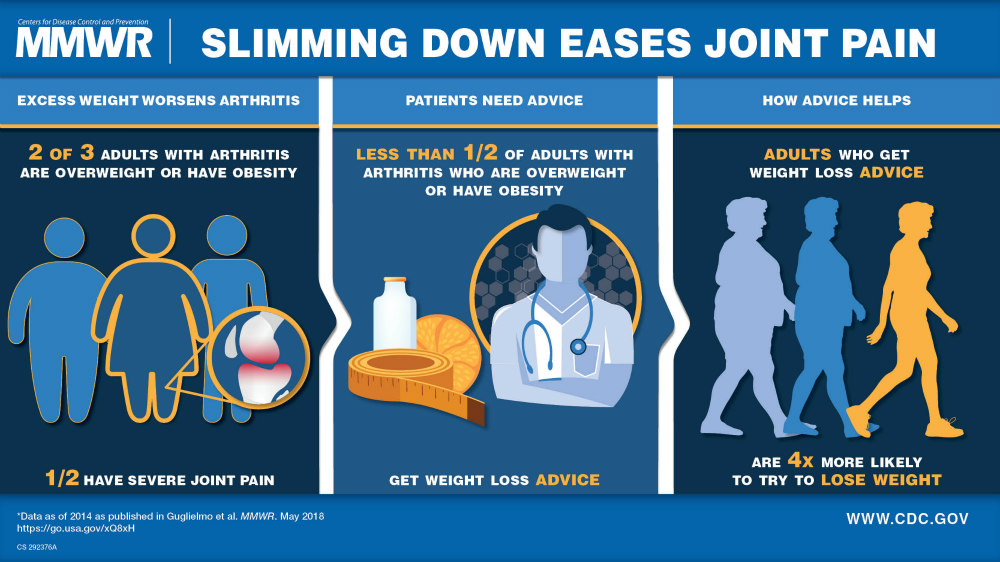
Understanding Arthritis: Fact,Types, Symptoms, and Prevention

According to the Centers for Disease Control and Prevention (CDC), Arthritis affects 54.4 million US adults, more than 1 of 4. It is a major cause of work disability in the United States and one of the most common chronic conditions in the nation. Arthritis is also a common cause of chronic pain.
What is Arthritis?
Arthritis describes more than 100 conditions that affect the joints or tissues around the joint. Experts have developed public health definitions of arthritis that include arthritis or related rheumatologic conditions. Most types of arthritis cause pain and stiffness in and around the affected joint or joints. Some types of arthritis, such as rheumatoid arthritis, also affect the immune system and some internal organs of the body.
What are the symptoms of arthritis?
Different types of arthritis have different symptoms. common symptoms for most types of arthritis are pain and stiffness in and around one or more joints. Depending on the type of arthritis, symptoms can develop suddenly or gradually over time. Symptoms may come and go, or persist over time.
What are type of arthritis?
Osteoarthritis (OA)
Osteoarthritis (OA) is the most common form of arthritis. Osteoarthritis affects over 30 million US adults. It is sometimes called degenerative joint disease or “wear and tear” arthritis. It most frequently occurs in the hands, hips, and knees.
Osteoarthritis is caused by damage or breakdown of joint cartilage between bones. These changes usually develop slowly and get worse over time. Osteoarthritis can cause pain, stiffness, and swelling, and can result in disability.
Signs and symptoms of Osteoarthritis include:
- Pain or aching.
- Stiffness.
- Decreased range of motion.
- Swelling.
Rheumatoid Arthritis (RA)
Rheumatoid arthritis (RA), is an autoimmune and inflammatory disease, which means that your immune system attacks healthy cells in your body by mistake, causing inflammation (painful swelling) in the affected parts of the body. RA mainly attacks the joints, usually many joints at once. RA commonly affects joints in the hands, wrists, and knees. In a joint with RA, the lining of the joint becomes inflamed, causing damage to joint tissue. This tissue damage can cause long-lasting or chronic pain, unsteadiness (lack of balance), and deformity (misshapenness).
RA can also affect other tissues throughout the body and cause problems in organs such as the lungs, heart, and eyes.With RA, there are times when symptoms get worse, known as flares, and times when symptoms get better, known as remission. The specific causes of RA are unknown, but some factors can increase the risk of developing the disease.
Signs and symptoms of RA include:
- Pain or aching in more than one joint.
- Stiffness in more than one joint.
- Tenderness and swelling in more than one joint.
- The same symptoms on both sides of the body (such as in both hands or both knees).
- Weight loss.
- Fever.
- Fatigue, or tiredness.
- Weakness.
Fibromyalgia
Fibromyalgia is a condition that causes pain all over the body or also referred to as widespread pain, sleep problems, fatigue, and often emotional and mental distress. People with Fibromyalgia may be more sensitive to pain than people without Fibromyalgia. This is called abnormal pain perception processing. Fibromyalgia affects about 4 million US adults, about 2% of the adult population. The cause of Fibromyalgia is not known, but it can be effectively treated and managed.
Signs and symptoms of Fibromyalgia include:
- Pain and stiffness all over the body.
- Fatigue and tiredness.
- Depression and anxiety.
- Sleep problems.
- Problems with thinking, memory, and concentration.
- Headaches, including migraines.
Other symptoms may include:
- Tingling or numbness in hands and feet.
- Pain in the face or jaw, including disorders of the jaw know as temporomandibular joint syndrome (also known as TMJ).
- Digestive problems, such as abdominal pain, bloating, constipation, and even irritable bowel syndrome (also known as IBS).
Gout
Gout is a common form of arthritis that usually affects one joint at a time (often the big toe joint) and is very painful. Men and obese adults are more likely to have gout. There are times when symptoms get worse, known as flares, and times when there are no symptoms, known as remission. Repeated bouts of gout can lead to gouty arthritis, a worsening form of arthritis. There is no cure for gout, but you can effectively treat and manage the condition with medication and self-management strategies.
Gout is caused by a condition known as Hyperuricemia, which is where there is too much uric acid in the body. The body makes uric acid when it breaks down purines, which are found in your body and the foods you eat. When there is too much uric acid in the body, uric acid crystals (monosodium urate) can build up in joints, fluids, and tissues within the body. Hyperuricemia does not always cause gout, and Hyperuricemia without gout symptoms does not need to be treated.
Gout flares start suddenly and can last days or weeks, followed by long periods of time—weeks, months, or years—without symptoms before another flare begins. Gout usually occurs in only one joint at a time. It is often found in the big toe. Along with the big toe, joints that are commonly affected are the lesser toe joints, the ankle, and the knee.
Symptoms in the affected joint(s) may include:
- Pain, usually intense.
- Swelling.
- Redness.
- Heat.
Childhood Arthritis
Arthritis in children is called childhood arthritis or juvenile arthritis. The most common type of childhood arthritis is juvenile idiopathic arthritis (JIA), also known as juvenile rheumatoid arthritis.Childhood arthritis can cause permanent physical damage to joints. This damage can make it hard for the child to do everyday things like walking or dressing and can result in disability.
Although there is no cure, some children with arthritis achieve permanent remission, which means the disease is no longer active. Any physical damage to the joint will remain.
The exact cause of childhood arthritis is unknown. In childhood arthritis the immune system may not work right which causes the inflammation in the joints and other body systems.Childhood arthritis can affect children of all ages, races and ethnic backgrounds.
Symptoms may come and go over time. There may be times when symptoms get worse, known as flares, and times when symptoms get better, known as remission.
Signs and symptoms include:
- Joint pain.
- Swelling.
- Fever.
- Stiffness.
- Rash.
- Fatigue (tiredness).
- Loss of appetite.
- Inflammation of the eye.
- Difficulty with daily living activities such as walking, dressing, and playing.
Am I at risk for arthritis?
Some behaviors and characteristics, called risk factors, certain factors make it more likely that you will develop arthritis. Some of these risk factors can be changed while others are not.
Risk Factors You Can Control or Modifiable risk factors are risk factors that you can control,these include:
- Overweight and Obesity
People who are overweight or obese are more likely to get knee osteoarthritis than people who are not overweight. Excess weight can also make knee osteoarthritis worse. Extra weight puts more stress on joints, particularly weight-bearing joints like the hips and knees. - Infection
Many microbial agents, like bacteria and viruses, can infect joints and potentially cause the development of some types of arthritis. - Joint Injuries
Joint injury or overuse such as knee bending and repetitive stress can damage a joint and contribute to the development of osteoarthritis in that joint. - Occupation
Occupations that involve repetitive knee bending and squatting are associated with osteoarthritis of the knee. - Smoking
Cigarette smoking increases a person’s risk of developing rheumatoid arthritis (RA) and can make the disease worse. It can also cause other medical problems. Smoking can also make it more difficult to stay physically active, which is an important part of managing RA and other types of arthritis.
Risk Factors You Cannot Control or Non-modifiable risk factors are risk factors that you cannot control, these include:
- Age
Your risk for most types of arthritis increases as you get older. - Gender
Most types of arthritis are more common in women, including osteoarthritis (OA), rheumatoid arthritis (RA), and Fibromyalgia. Gout is more common in men. Experts don’t know exactly why women are at higher risk for developing most types of arthritis, or why men are at higher risk for developing gout. - Genetics and Inherited Traits
People born with specific genes are more likely to develop certain types of arthritis, such as rheumatoid arthritis (RA), systemic lupus Erythematous (SLE), and ankylosing spondylitis. These genes are called HLA (human leukocyte antigen) class II genotypes. These genes can also make your arthritis worse. Experts do not know why people with these genes are at higher risk for developing arthritis or why it can make their arthritis worse.
Unlike some of risk factors above which may increase risk of developing RA, at least one characteristic may decrease risk of developing RA.
- Breastfeeding. Women who have breastfed their infants have a decreased risk of developing RA.
Can I prevent arthritis?
Making lifestyle changes can decrease your risk of getting some types of arthritis or making arthritis worse.There are steps you can take to reduce your risk of developing some types of arthritis:
- Maintain a healthy weight. Healthy eating and physical activity can help you lose weight and stay at a healthy weight.

- Be active. Research shows physical activity decrease pain, improve function, and delay disability. People with Arthritis should strive for 150 of moderate activity each week. .
- Protect your joints from injuries by doing special exercises for those joints. Visit the OA Action Alliance website for exercises to prevent knee injuries[PDF-3.46MB].
- See your doctor right away if your joints are swollen, warm, or red. It might be an infection.
- Make sure your worksite is free of fall hazards and has the space, equipment, and tools that fit your physical ability and limitations. Learn about ergonomics and musculoskeletal disorders from CDC’s National Institute for Occupational Safety and Health (NIOSH).
- Stop smoking. Multiple studies show that cigarette smoking increases a person’s risk of developing RA and can make the disease worse. Get help by visiting I’m Ready to Quit on CDC’s Tips From Former Smokers website.
Arthritis treatment is available now at South Atlanta Urgent Care Clinic in Atlanta.
Source:
CDC
Picture:
CDC
Read more:



Most Commented